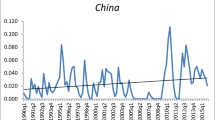Abstract
A cost-efficient way to allocate carbon dioxide (CO2) emission reductions among countries or regions is to harmonise their marginal reduction costs. This could be achieved by a market of emission reduction units (ERUs). To model such a market, we use a multi-regional MARKAL-MACRO model. It gives insights into the consequences of co-ordinating CO2 abatement on regional energy systems and economies. As a numerical application, we assess the establishment of a market of ERUs among three European countries for curbing their CO2 emissions.
Similar content being viewed by others
References
O. Bahn, B. Büeler, S. Kypreos and H.-J. Lüthi, Modeling an international market of CO2 emission permits, Int. J. Global Energy Issues 12 (1999) 283–291.
O. Bahn, A. Haurie, S. Kypreos and J.-P. Vial, Advanced mathematical programming modeling to assess the benefits from international CO2 abatement cooperation, Environmental Modeling and Assessment 3 (1998) 107–115.
B. Büeler, Computing economic equilibria and its application to international trade of CO2 permits: An agent based-approach, Ph.D. thesis No. 12493, Swiss Federal Institute of Technology, Zürich, Switzerland (1997).
L.G. Fishbone and H. Abilock, MARKAL, a linear-programming model for energy systems analysis: Technical description of the BNL version, Int. J. Energy Research 5 (1981) 353–375.
IPCC, Climate Change 1995 – Economic and Social Dimensions of Climate Change, Contribution of Working Group III to the Second Assessment Report of the Intergovernmental Panel on Climate Change (Cambridge University Press, Cambridge, 1996).
A. Kanudia and R. Loulou, Advanced bottom-up modelling for national and regional energy planning in response to climate change, Int. J. Environment and Pollution 12 (1999) 191–216.
T. Kram and D. Hill, A multinational model for CO2 reduction: Defining boundaries of future CO2 emissions in nine countries, Energy Policy 24 (1996) 39–51.
S. Kypreos, Assessment of CO2 reduction policies for Switzerland, Int. J. Global Energy Issues 12 (1999) 233–243.
S. Kypreos, Efficient CO2 mitigation options, A global analysis, in: Energy Models for Decision Support: New Challenges and Possible Solutions, eds. E. Laege and P. Schaumann, IER Stuttgart, Proc. Joint IEA-ETSAP/FEESWorkshop, Berlin, Germany (1998) pp. 99–112.
S. Kypreos, The MARKAL-MACRO model and the climate change, PSI Bericht Nr. 96-14, Paul Scherrer Institute, Villigen, Switzerland (1996).
R. Loulou and A. Kanudia, The Kyoto Protocol, inter-provincial cooperation, and energy trading: A systems analysis with integrated MARKAL models, Energy Studies Review 9 (1999) 1–23.
O. Lueth, A. Jattke, H. Schoettle, M. Wietschel, and O. Rentz, Emission reduction strategies for Central and Eastern Europe, Energy Policy 25 (1997) 305–312.
A.S. Manne, R. Mendelsohn and R.G. Richels, MERGE: A model for evaluating regional and global effects of GHG reduction policies, Energy Policy 23 (1995) 17–34.
A.S. Manne and R.G. Richels, Buying Greenhouse Insurance: The Economic Costs of Carbon Dioxide Emission Limits (MIT Press, Cambridge, 1992).
A.S. Manne and C.O. Wene, MARKAL-MACRO: A linked model for energy-economy analysis, BNL-47161, Brookhaven National Laboratory, Upton, New York (1992).
I. Nyström, Improving the specification of the energy-economy link for a systems engineering model, Applications for Sweden, Thesis for the Degree of Licentiate of Engineering, CTH-EST-R-95/5-SE, Chalmers University of Technology, Göteborg, Sweden (1995).
I. Nyström and G. Andersson, Documentation of the Swedish MARKAL-MACRO database, I-EST-95-4, Chalmers University of Technology, Göteborg, Sweden (1995).
R. Richels and P. Sturm, The costs of CO2 emission reductions: Some insights from global analyses, Energy Policy 24 (1996) 875–887.
United Nations, Kyoto Protocol to the United Nations Framework Convention on Climate Change, Conference of the Parties, FCCC/CP/1997/L.7/Add.1 (1997).
United Nations, Framework Convention on Climate Change, International Legal Materials 31 (1992) 849–873.
E. Van Der Voort, The EFOM-12C energy supply model within the EC modelling system, OMEGA The Int. J. Management Science 10 (1982) 507–523.
D. Vos, The Challenge project: Country report for the Netherlands, in: Proc. IEA-ETSAP/Annexe VI, 1stWorkshop, Leuven, Belgium (1996).
D. Wilson and J. Swisher, Exploring the gap: Top-down versus bottom-up analyses of the cost of mitigating global warming, Energy Policy 21 (1993) 249–263.
World Energy Council, International Energy Data, London (1995).
World Resources Institute, World Resources 1996–1997 (Oxford University Press, Oxford, 1996).
Author information
Authors and Affiliations
Rights and permissions
About this article
Cite this article
Bahn, O., Barreto, L. & Kypreos, S. Modelling and assessing inter-regional trade of CO2 emission reduction units. Environmental Modeling & Assessment 6, 173–182 (2001). https://doi.org/10.1023/A:1011914015053
Issue Date:
DOI: https://doi.org/10.1023/A:1011914015053




